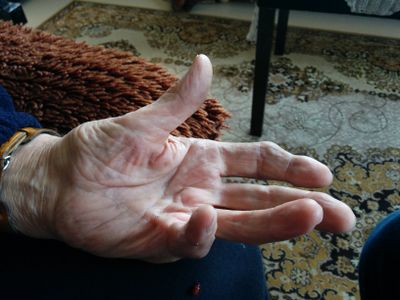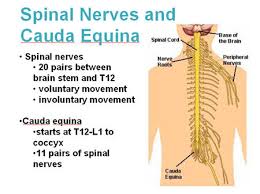Spinal cord anatomy
- Please do not edit unless you are involved in this project, but please come back in the near future to check out new information!!
- If you would like to get involved in this project and earn accreditation for your contributions, [[[Special:Contact|please get in touch]]]!
Original Editor - Add a link to your Physiopedia profile here.
Top Contributors - Naomi O'Reilly, Lucinda hampton, Kim Jackson, Nikhil Benhur Abburi, Vidya Acharya, Admin, Tarina van der Stockt, Aminat Abolade, Rucha Gadgil, Jess Bell and Ewa Jaraczewska
Introduction[edit | edit source]
Anatomy of the Spinal Cord[edit | edit source]
- The spinal cord lies within the vertebral canal, extending from the foramen magnum to the lowest border of the first lumbar vertebra.
- It is enlarged at two sites, the cervical and lumbar region.
- The lower part of the spinal canal contains the lower lumbar and sacral nerves known as the Cauda Equina.
- Sensory nerve fibres enter the spinal cord via the Dorsal (posterior) roots. The cell bodies for these neurons are situated in the dorsal root ganglia.
- Motor and preganglionic autonomic fibres exit via the ventral (anterior) root
This short video clip gives an overview of spinal cord anatomy.
| [1] |
Associated Pathways[edit | edit source]
Ascending Sensory Pathways
- Spinothalamic tract: From Dorsal horn laminae I,III,IV,V. crosses midline in spinal cord, projects to brain stem and contr-lateral thalamus. Conveys pain and temperature.
- Dorsal column Medial lemniscal pathway: Afferents from mechanoreceptors, muscle and joint receptors. terminates in dorsal column nuclei of medulla. Forms medial lemniscus at this level and synapses in ventroposterior nucleus of thalamus. Conveys proprioception, light touch and vibration.
- Spinocerebellar tract: From spinal cord interneurons. It has two tracts a) Dorsal SCT relays via inferior cerebellar peduncle and b) VCT relays via superior cerebellar peduncle to the cerebellum. It conveys proprioceptive information and on-going activity in the spinal cord interneurons.
Descending Motor Tracts
- Corticospinal (pyramidal) tract: From the motor cortex, premotor cortex, and somatosensory cortex. Has a role in sensory processing and fractionated finger movements.
- Rubrospinal tract: Originates from the magnocellular part of the red nucleus in the brain. It projects towards common structures with the CoST, particularly those involved with distal motor control. There is debate as to how significant this tract is.
- Vestibulospinal Tract: Originates from Deiters nucleus in the medulla and innervates the extensor and axial muscles. It is involved in balance control and posture.
- Reticulospinal Tract: This tract begins in the caudal reticular formation in the pons and medulla. Provides both excitable and inhibitory effects on the interneurons in the spinal cord, and to a lesser extent, it also acts on the motor neurons. Its main action is to dampen down activity in the spinal cord. without this pathway, there is increased extensor tone observed.
Sub Heading 2[edit | edit source]
Add text here...
Sub Heading 3[edit | edit source]
Add text here...
References[edit | edit source]
References will automatically be added here, see adding references tutorial.
- ↑ Handwritten tutorials. Spinal Pathways 1 - Spinal Cord Anatomy and Organisation. Available from: http://www.youtube.com/watch?v=5B87zsAKmWc [last accessed 29/08/16]








